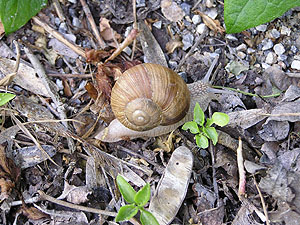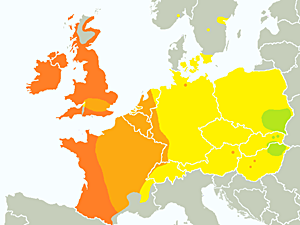
Only influence of man in the primordial forests of postglacial
Central Europe made possible the settling of Roman snails
from south of the Alps. [RN]
The original distribution area of Roman snails (Helix pomatia) and their relatives is located in South-Eastern Europe. Not only are there habitats best suitable for Roman snails and other terrestrial snail groups, but also rich limestone soils. So South-East Europe as well as Asia Minor today are a distribution centre of numerous Helix species and their relatives. Only few of those, though, are as well known as those species commercially used.
 Only influence of man in the primordial forests of postglacial Central Europe made possible the settling of Roman snails from south of the Alps. [RN] |
Today it is assumed that the Roman snail survive the last ice age south of the Alps. When the glaciers melted away, the Roman snail began to traverse the Alps to the North. In the Neolithic, this migration was assisted by human settlement. At that time, though, snails were only rarely used as food. Human settlements were accompanied by clearing of the primordial forest to make place for fields and gardens. So, man created habitats suitable for Roman snails and many of their relatives, in contrary to the primordial forest that had predominantly covered large areas of Europe before.
Later in the so-called Ancient ages, the Roman snail was, to a large extent, distributed by the Romans in the different parts of their empire. Many findings of Roman snail shells from that time, document their importance as food. Because of its introduction on the British Isles by the Romans, Helix pomatia is called "Roman snail" in English, in contrary for example to the brown garden snail or common snail, Cornu aspersum, that was introduced to Britain probably long before that time.
In the Middle Ages snails were eaten as lent food – they are not mentioned among the prohibited foods, such as fish or meat. Especially around monasteries, snail gardens were founded, where the snails picked in nature were fattened to be eaten.
Even during Napoleon's conquests, hibernating snails were taken as a natural conserve.
Apart from those described reasons for introducing snails in foreign countries, it is assumed today, that Helix pomatia's current area of distribution is a consequence of both natural and man-made factors. Not taking into account cultivated snails exported, they are in fact quite frequently introduced by fruit and vegetable transports. The Roman snail, or Helix pomatia, today is further distributed than at any time in its history.
The natural area of distribution of the Roman snail from Central Europe reaches to Central France and Southern England in the West, Southern Sweden and Norway in the North and as far as Estonia, Belarus and the Western Ukraine in the East. In the South, the Roman snail is distributed as far as Northern Italy, on the Balkan Peninsula as far as Macedonia.
 Man not only made possible the distribution of the Roman snail into central Europe, he also is its greatest threat. [CK] |
 Distribution of Helix pomatia and its relatives in Europe: Orange: Cornu aspersum. Yellow: Helix pomatia. Green: Helix lutescens. Light orange; Area where both pomatia and asper- sum are found. The map is restricted to the area discussed by KERNEY et al. 1983. |
Despite its geographically widespread distribution the Roman snail must be counted among the threatened species in vast parts of its distribution area – in many countries it appears on the red lists.
The reason for the dire straits the Roman snail is in, as usually is to be seen in man-made influence on the environment. The open habitats, that had been formed by man, and that in principle are very suitable for snails, are over-fertilised and poisoned by herbicides. So they become uninhabitable for snails. In most garden areas snails and slugs alike are poisoned by slug pellets, so those habitats become as uninhabitable to gastropods. The increasing aerial pollution makes also for an additional threat to snails: Acid rain corrodes their shells on one hand and acidifies the soil on the other. This is especially negative to snails preferring alkaline soils, Roman snails among them.
Additionally snails are assumed to be impaired in their reproduction by acid rain.
The already diminished populations of Roman snails additionally have been affected by uncontrolled picking of snails for trade and cultivation. Wild Roman snails today may not be picked anymore in all of their Central European area of distribution. Cultivation of snails could be a solution to that special problem. But this part of agriculture would still be in competition with snails picked from nature in countries like Poland, where it is still legal to do so.
This, alas, of all parts of life, is one where the European Community does not take any influence.